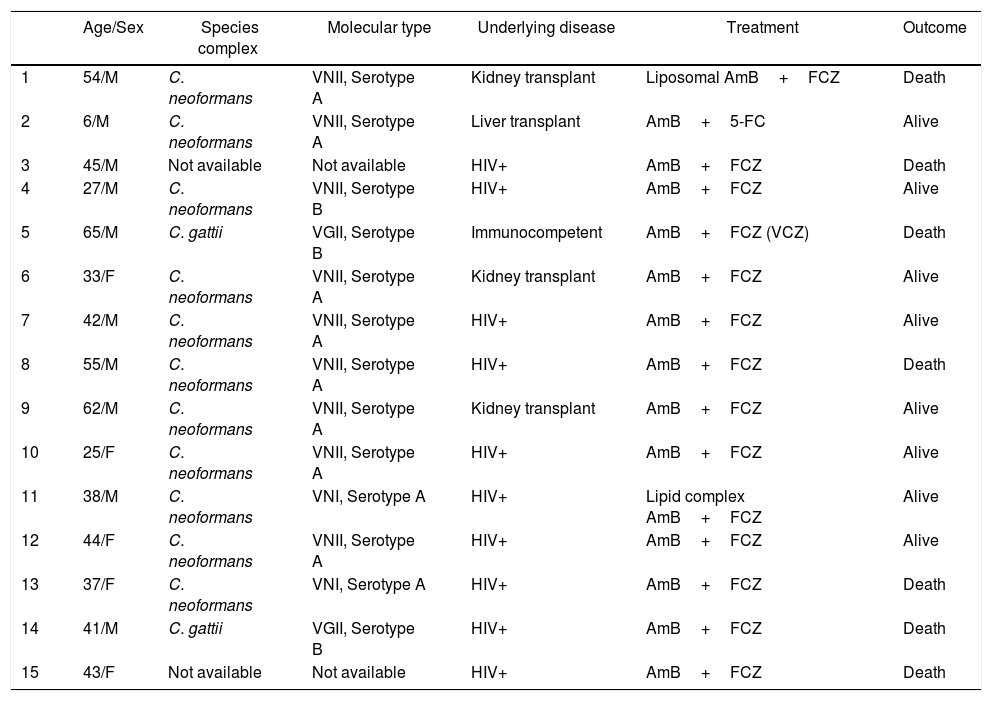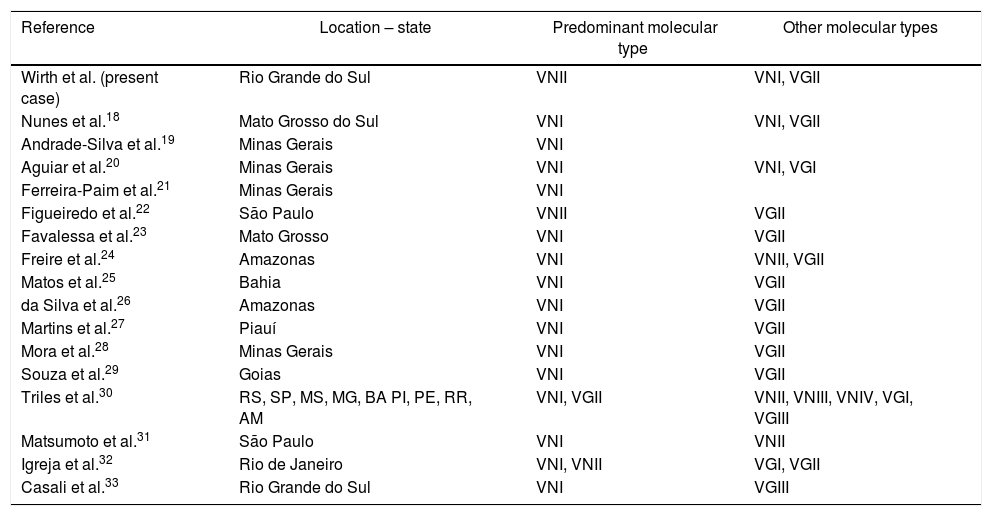There are limited data on the molecular epidemiology of cryptococcosis in Brazil. Here, we report on the identification of the molecular pattern of the Cryptococcus species that caused meningitis in patients admitted in a Brazilian reference tertiary care hospital, and review the published studies addressing the molecular epidemiology of Cryptococcus in Brazil. Our study has shown the predominance of molecular type VNII in HIV-infected patients with cryptococcal meningoencephalitis. Molecular types VNII and VGII were occasionally detected in HIV-infected and non-infected patients with meningoencephalitis. In contrast, previous studies have shown that several regions exhibited a high prevalence of the VNI molecular type and sporadic cases of the VNII and VGII molecular types in patients with cryptococcosis in Brazil. Additional studies including VNII isolates will contribute to understanding the epidemiology and phylogenetic relationship of these genotype compared to the other ones. So far, no clear correlation has been established between genotypes, antifungal susceptibility for Cryptococcus and clinical outcome in cryptococcosis.
Cryptococcosis is a systemic mycosis primarily caused by Cryptococcus neoformans species complex. The C. neoformans complex includes the molecular types VNI, VNII, VNB, VNIII, and VNIV, and the C. gattii species complex, which includes the molecular types VGI, VGII, VGIII, and VGIV.1,2 Members of the C. neoformans species complex are responsible for most cases of cryptococcosis associated with AIDS. Using genotyping techniques four major molecular types can be identified VNI, VNII, VNB, VNIV, in addition to the AD hybrid. VNI and VNII have a worldwide distribution.3 In terms of serotypes, three varieties are recognized: C. neoformans var. grubii, serotype A, C. neoformans var. neoformans, serotype D, C. neoformans var. gattii, serotypes B and C, and the hybrid serotype AD.4–6
Meningitis is the most serious infectious due to Cryptococcus sp. The human immunodeficiency virus (HIV)/AIDS pandemic increased the population of immunosupressed and susceptible individuals and brought an increase in C. neoformans infection rates, but the increasing number of people living with any other immunodeficiency, including transplant and cancer patients, represents a growing population at risk for cryptococcosis.7,8
The recent availability of DNA fingerprinting techniques extended our knowledge about C. neoformans epidemiology over the past years. Naturally, the randomized amplified polymorphic DNA, PCR-fingerprinting, restriction fragment length polymorphism, karyotyping, allele sequencing, and multilocus enzyme electrophoresis helped us to answer several questions. PCR fingerprinting technique has been used as the major typing technique in the ongoing global molecular epidemiologic survey of C. neoformans, dividing >400 clinical and environmental isolates into eight major molecular types: VNI (var. grubii, serotype A), VNII (var. grubii, serotype A), VNIII (serotype AD), VNIV (var. neoformans, serotype D), VGI, VGII, VGIII, and VGIV (var. gattii, serotypes B and C). No correlation between serotype and molecular type has been found for C. neoformans var. gattii. The molecular types were recently confirmed by RFLP analysis of the orotidine monophosphate pyrophosphorylase (URA5) gene and the phospholipase (PLB1) gene.9–13
Currently, there are limited data on the molecular epidemiology of cryptococcosis in Brazil. Here, we report on the identification of the molecular pattern of the Cryptococcus species that caused meningitis in patients admitted in a reference Brazilian tertiary care hospital, and review the published studies addressing the molecular epidemiology of Cryptococcus in Brazil.
Cryptococcus sp. was isolated from the cerebrospinal fluid of patients with meningoencephalitis admitted at Hospital de Clinicas de Porto Alegre, 700-bed tertiary Brazilian reference hospital, from January 2014 to December 2015. Initially, C. neoformans and C. gattii were distinguished by a phenotypic method – CGB agar (cavanine glycine bromothymol blue agar). Detailed demographics, risk factors, treatment regimens and clinical outcome of the patients with meningeal cryptococcosis were evaluated from medical records. The study was approved by the local ethics committee. Cryptococcus complex reference strains were very kindly provided by Laboratory of Mycology (Pathogenic Fungi Collection), at Oswaldo Cruz Foundation (FIOCRUZ) – INI/FIOCRUZ in Brazil. The strains included were the following: WN=M 148 (VNI, serotype A), WM 626 (VNII, serotype A), WM 628 (VNIII, serotype AD), WM 629 (VNIV, serotype D), WM 179 (VGI, serotype B), WM 178 (VGII, serotype B), WM 161 (VGIII, serotype B) and WM 779 (VGIV, serotype C). The extraction of genomic DNA and RFLP analysis was performed according protocol using 2 primers: URA5 (5′ATGTCCTCCCAAGCCCTCGACTCCG3′) and SJ01 (5′ TTAAGACCTCTGAACACCGTACTC3′). RFLP patterns were assigned visually by comparing them to the patterns obtained from the standard-type strains (VNI-VNIV and VGI-VGIV).14,15
Fifteen patients with cryptococcal meningoencephalitis were evaluated in the study (Table 1). The gene URA-5 RFLP showed that nine patients had VNII, serotype A, two patients VNI serotype A, and two had VGII, serotype B isolate from their CSF samples. Two patients presented a positive CSF cryptococcal polysaccharide antigen, and Cryptococcus could not be isolated from the CSF samples. As expected, the VNII, serotype A strains were isolated from patients with underlying immunossupressive disease. HIV positive was the most common condition, followed by kidney and liver transplant. Meningoencephalitis by C. gattii was diagnosed in two patients. One of them was immunocompetent and the other presented an immunosuppressive condition (HIV). Clinical isolates were highly susceptible to amphotericin B and fluconazole by microdilution method (data not shown). In Brazil, studies of the invitro susceptibility of Cryptococcus spp. have shown that most isolates are susceptible to polyene antifungals, 5-flucytosine, and azoles.16
Cryptococcus species complex and genotype identification in the CSF samples from patients with cryptococcal meningitis.
| Age/Sex | Species complex | Molecular type | Underlying disease | Treatment | Outcome | |
|---|---|---|---|---|---|---|
| 1 | 54/M | C. neoformans | VNII, Serotype A | Kidney transplant | Liposomal AmB+FCZ | Death |
| 2 | 6/M | C. neoformans | VNII, Serotype A | Liver transplant | AmB+5-FC | Alive |
| 3 | 45/M | Not available | Not available | HIV+ | AmB+FCZ | Death |
| 4 | 27/M | C. neoformans | VNII, Serotype B | HIV+ | AmB+FCZ | Alive |
| 5 | 65/M | C. gattii | VGII, Serotype B | Immunocompetent | AmB+FCZ (VCZ) | Death |
| 6 | 33/F | C. neoformans | VNII, Serotype A | Kidney transplant | AmB+FCZ | Alive |
| 7 | 42/M | C. neoformans | VNII, Serotype A | HIV+ | AmB+FCZ | Alive |
| 8 | 55/M | C. neoformans | VNII, Serotype A | HIV+ | AmB+FCZ | Death |
| 9 | 62/M | C. neoformans | VNII, Serotype A | Kidney transplant | AmB+FCZ | Alive |
| 10 | 25/F | C. neoformans | VNII, Serotype A | HIV+ | AmB+FCZ | Alive |
| 11 | 38/M | C. neoformans | VNI, Serotype A | HIV+ | Lipid complex AmB+FCZ | Alive |
| 12 | 44/F | C. neoformans | VNII, Serotype A | HIV+ | AmB+FCZ | Alive |
| 13 | 37/F | C. neoformans | VNI, Serotype A | HIV+ | AmB+FCZ | Death |
| 14 | 41/M | C. gattii | VGII, Serotype B | HIV+ | AmB+FCZ | Death |
| 15 | 43/F | Not available | Not available | HIV+ | AmB+FCZ | Death |
M, male; F, female; AmB, amphotericin B deoxycholate; FLZ, fluconazole; VCZ, voriconazole.
Although we analyzed a small number of isolates, our study has shown the predominance of VNII Cryptococcus genotype in patients with meningoencephalitis. Previous studies have shown that the VNI molecular pattern is the most common pattern worldwide, whereas VNII was observed in 1%–16% of cases reported in South America, Africa, and Oceania.17,2C. gattii VGII was also observed in South America, North America, and Oceania. Table 2 describes the studies evaluating the Cryptococcus genotypes circulating in Brazil.18–33 Several regions exhibited a high prevalence of the VNI molecular type and sporadic cases of the VNII and VGII molecular types in Brazil. The predominance of the VNI molecular type has been described in the States of São Paulo, Minas Gerais, Mato Grosso, Amazonas, PIauí, Rio Grande do Sul and Rio de Janeiro in Brazil.
Studies addressing the prevalence of Cryptococcus molecular types in cryptococcosis in Brazil.
| Reference | Location – state | Predominant molecular type | Other molecular types |
|---|---|---|---|
| Wirth et al. (present case) | Rio Grande do Sul | VNII | VNI, VGII |
| Nunes et al.18 | Mato Grosso do Sul | VNI | VNI, VGII |
| Andrade-Silva et al.19 | Minas Gerais | VNI | |
| Aguiar et al.20 | Minas Gerais | VNI | VNI, VGI |
| Ferreira-Paim et al.21 | Minas Gerais | VNI | |
| Figueiredo et al.22 | São Paulo | VNII | VGII |
| Favalessa et al.23 | Mato Grosso | VNI | VGII |
| Freire et al.24 | Amazonas | VNI | VNII, VGII |
| Matos et al.25 | Bahia | VNI | VGII |
| da Silva et al.26 | Amazonas | VNI | VGII |
| Martins et al.27 | Piauí | VNI | VGII |
| Mora et al.28 | Minas Gerais | VNI | VGII |
| Souza et al.29 | Goias | VNI | VGII |
| Triles et al.30 | RS, SP, MS, MG, BA PI, PE, RR, AM | VNI, VGII | VNII, VNIII, VNIV, VGI, VGIII |
| Matsumoto et al.31 | São Paulo | VNI | VNII |
| Igreja et al.32 | Rio de Janeiro | VNI, VNII | VGI, VGII |
| Casali et al.33 | Rio Grande do Sul | VNI | VGIII |
RS, Rio Grande do Sul; SP, São Paulo; MS, Mato Grosso do Sul; MG, Minas Gerais; BA, Bahia; PI, Piauí; PE, Pernambuco; RR, Roraima; AM, Amazonas.
Studies of molecular types of Cryptococcus contribute to the evaluation of the epidemiology, clinical manifestations, interventions and therapeutic approach for cryptococcosis. The presence of molecular type VNII was reported in all five continents, but little is known about its pathobiology, ecology, and antifungal susceptibility. Therefore, tools that are able to identify it are important to better understand how it is distributed in the environment, how it interacts with the host, and finally if it needs a different and more specific treatment to improve the patient outcome. Additional studies of VNII isolates will contribute to understanding the epidemiology and phylogenetic relationship of this genotype compared to the other ones, revealing if it represents a separate species in the C. neoformans species complex.
Conflicts of interestThe authors declare no conflicts of interest.
The study was supported in part by CNPq (Brazilian National Council of Research).







